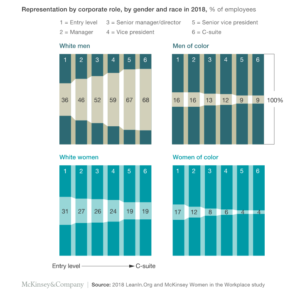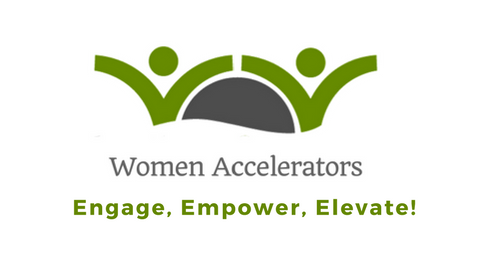According to a recent joint study from McKinsey and Lean In, progress towards gender equality in the workplace has not just slowed down but stalled completely. “Only about 1 in 5 C-suite leaders is a woman, and only 1 in 25 is a woman of color.” Contradictory to the typical arguments, women are earning comparable education and experience, asking for promotions and also staying in the workforce at similar rates to men.
So why is there still such a large disparity?
According to the study, the management of talent pipelines might be to blame. From day one in an organization, cultural aspects will impact how minorities and women are seen. But also how they are interacted with (potential discrimination), grow (access to senior leaders and/or mentorship/sponsorship), and feel included (are you the “only” woman in the room?). Many companies talk the talk but do not walk the walk. In other words, we need leaders to show and consistently act on promises to create a more diverse workforce. Check out the article and link to the complete study here: https://mck.co/2ORF0Ob
For women and minorities seeking career growth, lets even say – at the speed of their peers, it is important to be cognizant of the organization’s culture and how it impacts our personal experiences and opportunities. While some organizations do not have a culture conducive to growing and nourishing female leadership and inclusion, there is a lot that DO. The trick is deciphering between the two. To do so, you need to pay close attention to the culture and the pipeline that shapes employee growth.
It is important to remember that a job interview is more than just an evaluation of your skills and credentials, it is a chance for YOU to interview the company.
Here are 3 tips to spot a glass ceiling before signing the offer letter to join ranks within an organization:
1. Take time for introspection
Clearly define your expectations and needs within an organization.
What is most important to you in order to thrive? Opportunity, networking potential, and sponsorship/mentorship are common needs for anyone in an organization but what does that look like for an inclusive workplace? Some organizations are lacking resources for minority and female employees so it is important to decide what you desire and need. Do you want pre-existing organizations set up or is it enough to have diverse backgrounds in the organization? Some may argue lean in circles are important for female inclusion. Is work flexibility important? Many organizations create more flexible work environments to help increase the retention of female high performers but that might not be a breaking point in your job search. How does the organization recognize and give feedback to their employees? For some, and in larger organizations, if feedback or ratings are not explicit, the role and progression can be difficult to navigate or question.
The bottom line to remember is that all women have different “ideal” work environments. Understanding what an ideal environment looks like to you will help you start the search, figure out what questions to ask and refine what companies to apply to.
2. Do your homework
your homework
-
- Dig deep into the organization’s public website. What information is available on the culture, mission, and vision? How large is the organization? Is anything listed about diversity and inclusion? If so, what does it tell you about the organization (statistics, business plan, action plan etc..)? Many organizations also have leadership profiles listed on their website, what does that tell you about the organization? If they do not have any diversity on the leadership team, that might be a red flag.
- Look at job review sites. Like any mass anonymous review site (see yelp), it’s important to take these with a grain of salt. However, reading multiple reviews may at least help you develop a list of potential topics to probe. An issue mentioned across multiple reviews may be indicative of a cultural trend within a company, especially if respondents are from multiple departments or locations. Some good large scale review sites to check out are: indeed, glassdoor, career bliss. Another site for women by women: fairygodboss.
- Reach out. This takes time. LinkedIn is a wonderful tool to find jobs and also to make connections. Before you even apply to a role, spend time finding a few current employees on LinkedIn. Reach out with a message and ask if they have a few minutes to speak to you about their job or organization- also known as an informational interview. While most people want to help, you likely won’t get a response to every message you send. Don’t get discouraged! If you aren’t getting any responses, adjust the message. It helps to be specific in your inquiry. Ask for what you want to learn about up front to shape the conversation but always remember this person may be a future co-worker. Tip: Find someone you have something in common with and you may get a better response rate. If you are able to speak with someone, ask them about their personal experiences. This genuine human connection will most likely provide more detailed insight than you can find online from any public site or anonymous review.
3. Ask the hard questions
*Certainly focus initially on questions about the role but don’t forget the important cultural and environmental questions! The formal interview is an opportunity for you to interview the employer too. Take note of how you are treated, how the office environment is set up, how employees interact and the body language between people.
- What is the culture like here?
- How is feedback provided or how is success rated?
- What are the daily expectations for a time in and out of office? Any flexibility of schedule? (be careful of when and who you ask this question but do include if important to you)
- Consider the environment of the office & ask to take a tour – are you comfortable with the surroundings/interactions?
- What is the leadership team like?
- How is inclusion encouraged within this organization?
- Do you have any mentorship programs? Or networking groups?
- Why is this position open?
- What makes you stay at this organization
Although most modern day companies speak to the value they put on diversity and inclusion, it isn’t always as transparent as we might hope. Learning to listen carefully and being brave enough to ask the tough questions can help female candidates identify gender inclusive employers.
Finally, remember that we are in this together. Empower, Engage and Elevate!


